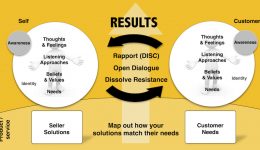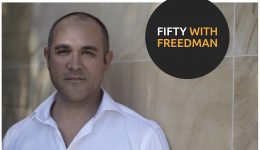CONSCIOUS SELLING (PART 2)
This article is part two in a series. To read part one click here.
All effective businesses have a strong team of salespeople. It’s vital for 99% of businesses today. Because without customers who want to buy your products or services, the cash flow dries up and the doors of the business close. This is not rocket science. And so in this article, we’ll explore some more of the behaviours, skills and tools which help sales people to fly. We pick it up at number 5.
5 Clarify what the customer actually means.
One of the fascinating concepts to wrap your head around is that we all perceive what we hear differently. All 7 billion humans are different in some way and this creates havoc for how we communicate. As your customer is sharing their challenges and ideals and observations, the way in which you hear them will not be identical to what they mean. As you hear their words, your brain will seek out memories from your past experiences to make sense of what they are saying. Because your experiences differ from theirs, you can never truly and fully understand what they are saying. Empathy comes in degrees and one of the ways to sharpen yours is to reflect back what you are hearing as a way to check you properly understand them. Start with these 2 simple active listening techniques or make up your own. “So what I’m hearing you say is…” or “So it sounds like you….”
6 Broaden your range of listening styles.
In addition to the understanding of DISC, another great tool which explores how to build stronger rapport, trust and relationships with customers is through the personal listening profile. A lot of resistance happens in sales conversations, because a customer does not feel like they have been heard and understood properly. And no matter how good the product or service is, if the customer doesn’t gel with the salesperson, it’s highly likely they will seek out a solution elsewhere. I’ve seen this profound tool have a dramatic effect on people’s understanding of both themselves and other people. The tool explains the five different types of listening approaches:
- Appreciative listening is about relaxing and enjoying the listening experience. It’s important for making the customer feel at ease.
- Empathic listening is about supporting and understanding the emotions of the speaker and is important when a customer is sharing personal information or feels stressed.
- Discerning listening is about gathering complete and accurate information and is vital particularly when the product being sold is complex or the customer is not fully aware of what they want yet.
- Comprehensive listening is about organising the information and understanding the meaning of the message. This comes in handy to dig beneath the surface to understand more about what the customers intrinsic needs are.
- Evaluative listening is about critiquing information to make a decision and this helps you distinguish between real buyers and people who are not ready to buy yet.
Everyone of your sales people have different listening strengths and development areas and when they understand this, it opens up potential for personal growth. You can download a sample of the tool here and if you want to find out any more about it, get in touch with me here.
7 Position the benefits to align with their DISC buying preferences.
Most salespeople understand the concept of focussing on the benefits (how the feature helps the customer), rather than it’s features (what the product does). What I teach people in my program is how to combine DISC together with selling benefits in order to create a pitch which talks the customers language. Download this free tool to apply this to your products and services.
8 Build common ground.
If you look at the sales dialogue map on the first part of this article, you’ll see the visual representation of what common ground is and how to reach it. There are 2 people. One is selling and product or service and the other is (hopefully) buying it. As the sales person asks questions and uses a range of techniques to build rapport and dig deeper into the customers challenges or pain points, they gain information. This is a cyclical process, whereby the sales persons, asks, then clarifies, asks then clarifies and keeps going until there is not much more to talk about. By this point in the conversation, the customer will have shared a huge amount about what they are looking for and now is the time for the salesperson to change the style of the conversation from asking and listening to speaking and presenting. And the best way this is done is by building bridges or links between the customers needs and your solutions. This is done by using the following phrase (or something similar). “So you said that you want …… and our product does exactly that … let me show you.” Here the sales person has accurately defined the customers problem and then presents the product in way which illustrates how it can be used as a solution.
9 Find the win / win territory for both parties.
This requires a high degree of consciousness on behalf of the sales person. A win/win solution is something which both parties feel is of mutual benefit to them. Each person walks away from the deal feeling that they have won. And this is the territory in the conversation which often boils down to price. If the customer pays over the market value for something and then finds out later, the trust in the sales person and the brand will be badly damaged, which doesn’t bode well for repeat sales. And if the sales person undercuts the competition so much, he or she will not meet their targets and this does damage to the companies profits and operating costs. A win win is the place in the middle where both the buyer and seller can walk away feeling good about the trade. This territory needs to be understood before the sales dialogue starts and can be established by answering 3 questions. What is a win for me, but a lose for the customer? What is a win for the customer but a lose for me? What is a win/win for both of us? By knowing these three spaces, you know when to engage, when to negotiate harder and when to walk away.
10 Close without fear.
Many sales people fear closing. They associate the feeling when a customer says no, to the idea that they are being personally rejected and so avoid pushing too hard to close. They might do steps 1 – 9 in textbook fashion, then shake their customers hand and say give me a call when you’re ready. Closing is vital and whereas many salespeople try to close too quickly because of their own impatience, and stuff things up as a result, not trying to close is just as bad. A great exercise for your sales team over a morning coffee is to ask them to each bring 5 questions they have successfully used to close a sale and then share them. That way you’ll build a smorgasbord of sales closers for the whole team in about half an hour.
If you would like any more information about my sales skills training or other programs, reach out and get in touch. I’d love to talk to you.




















